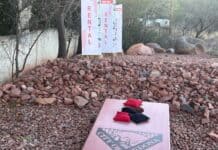On Thursday, Dec. 20, a proposed housing project west of Sedona goes before Yavapai County Planning and Zoning Commission for the first of several meetings requesting a zone change on a 172-acre parcel.
The property has been for sale for roughly 10 years but no one has moved forward with a serious offer until now. The prospective buyer is asking for a zone change to build 600 housing units on the pristine El Rojo Grande Ranch.
The owner will be selling the parcels at a loss. The parcels were purchased in 2003 for $10 million, equal to $13,721,378 in 2018 dollars. Taxes on the properties over the last 15 years, when adjusted for inflation, amount to an estimated $1,157,825, meaning the total amount spent on the property is $14,879,203, but it’s only being sold for $14.2 million, meaning the owner stands to lose $679,203, not counting other costs that may have been incurred over the last 15 years.
While area residents oppose the zone change, no one has offered to buy the property, so it’s understandable why the property owner is willing to and the financial hit.
We strongly urge the Yavapai County Board of Supervisors to reject this zone change. The project is ill-suited for the property.
The developers are asking to rezone the parcel and increase density eightfold, which seems like a wildly excessive attempt to cram as many bodies onto the property as physically possible. The 600 units would pay an average of $1,000 per month, meaning the new property owners stand to make $7.2 million per year, if the county approves this over-the-top density on a fragile landscape.
While the developer touts economic benefits, homeowners won’t own the land beneath their floorboards, which will still be owned in perpetuity by the developer, who could jack up the rent for the “privilege” of living at the site to $2,000 or $3,000 a month once homeowners move in. The developer provides nothing at that point, but gets to milk the tenants, many living on fixed incomes.
There is neither infrastructure nor amenities to accommodate these new homeowners. There are no stores nor facilities planned, meaning residents will have to drive into Sedona or Cottonwood for food, groceries, gas, entertainment and employment.
Seniors who move into the project are not going to walk the 2.5 miles to Sedona — there are no sidewalks anyway — so if they want anything from dinner to a Snicker’s bar, they’ll be in their car, on the road, clogging traffic.
While it may boost the economy, the added vehicles will add to Sedona’s traffic woes. Right now the western entrance to Sedona is the only way into the city that isn’t consistently overcrowded. Why would the county want to add so many more drivers to the one route Sedona residents can use to leave the city without a headache?
The fact that the project is yet another 55-and-older community means the vast majority of Sedona’s workforce will be unable to buy. With the increasing numbers of vacation rentals strangling Sedona’s long-term rental market, the project offers zero help. And what safeguards are in place to prevent these homeowners from turning their properties into vacation rentals themselves?
In fact, as most of the residents likely to move there won’t be working, dumping 1,200 new people just outside the city only adds more customers to the economy that will need workers to serve them, pushing employment costs higher and offsetting any added benefits to small business owners.
At a Sedona City Council meeting Oct. 9, representatives for the developer suggested that as many as 30 percent of the homeowners will join Sedona’s workforce. It sounds nice, but 100 percent could be working if the property was open to all ages.
Sunset Hills and Sedona Shadows already provide two housing developments on the edge of the city that young families cannot move into. Do we need a third one, twice the size, that only multiplies the existing issues?
If the developer really claims the new project will benefit Sedona and the Verde Valley, remove the age restriction on home ownership so working families have somewhere to buy rather than having to look far outside our city if they want to buy a home.
At least the new developments in Cottonwood and Clarkdale, which will add 2,500 homes over the next decade, are not so myopic as to limit property ownership to just seniors. Those communities know that to increase their workforce and provide livable communities, homeownership must be a multi-generational offering.
Residents who want to voice opposition to this project should call and email every member of the Yavapai County Board of Supervisors and voice opinions in person at the upcoming meetings before the county Planning and Zoning Commissions on Thursdays, Dec. 20 and Jan. 17; and the Board of Supervisors on Wednesday, Jan. 16, Thursday, Feb. 7, and Wednesday, Feb. 20.
Christopher Fox Graham
Managing Editor
